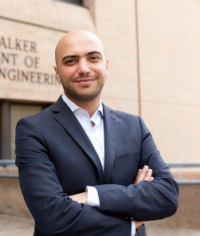
Unbiased Early Colorectal Cancer Polyps Diagnosis Using Generative-AI Data Augmentation and a Complementary Trustworthy Clinician-AI Interactive Framework
SIGNIFICANCE AND IMPACT
Cancers of the gastrointestinal (GI) tract pose significant challenges to global healthcare systems due to their increasing prevalence and high mortality rates. According to the World Health Organization, colorectal cancer (CRC) was the third most common cancer worldwide, affecting around 1.9 million people and causing 935,000 deaths in 2020 [1]. In the same year, Gastric cancer (GC) ranked as the fifth most frequently diagnosed cancer globally, with up to 62% of cases detected at advanced stages, leading to poor survival outcomes [2]. Survival rates for the involved cancer patients vary considerably depending on the tumor stage at the time of detection, emphasizing the importance of early identification and removal of pre-cancerous lesions through endoscopic procedures. Timely and accurate diagnosis can significantly reduce patient deaths to around 10%.
GI tract lesions are typically identified based on their morphological characteristics observed on video during endoscopic procedures [3-6]. However, these characteristics often overlap significantly, leading to high variability and disagreement among clinicians. This makes the diagnostic process subjective and dependent on the evaluator, requiring long-term, specialized training and experience from clinicians [7, 8]. Despite advancements in endoscopic imaging techniques, this reliance on subjective assessments has resulted in suboptimal detection rates and inconsistent classification of these lesions. Additionally, technical limitations, such as visual obstructions, lighting changes within the body, as well as inadequate resolution and steerability of endoscopic and colonoscopy devices (as the gold standard approach for diagnosis of GI tract cancers) further complicate these challenges and increase the early detection miss rate of cancerous polyps [7].
CURRENT AI APPROACHES AND THEIR LIMITATIONS
To address the limitations above in detecting and classifying gastrointestinal tumors, Computer-aided Diagnostics (CADx) methods utilizing Artificial Intelligence (AI) and Machine Learning (ML) have been increasingly employed across various modalities, such as histopathological images and endoscopic videos. These techniques can be utilized through post-processing or real-time assistance during endoscopic procedures. However, a very recent study has shown that CADx methods in colonoscopy neither improve the detection of colorectal lesions nor increase the burden of the procedure in real-world, nonrandomized studies [9]. This reveals a gap in current methodologies applied by researchers in developing CADx methods, calling into question their generalizability.
Several issues plague AI methods for CADx in the medical domain. One significant challenge can be attributed to the scarcity and imbalance of available datasets, which directly affects the generalizability and performance of AI models and leads to disparate and biased detection outcomes [10]. Models trained on sparse and unbalanced datasets are susceptible to overfitting, producing inaccurate predictions, and exhibiting inherent bias. Obstacles such as patient privacy concerns, and medical expertise requirements for data acquisition and labeling, hinder the creation of large, well-balanced datasets [11]. Furthermore, population disparities concerning geography (i.e., rural, or urban), gender/sexuality (i.e., women’s health), race and ethnicity, as well as socio-economic status cause that not all populations are adequately represented in the trained models, leading towards inadequate model performance and bias [12].
Research indicates that incorporating balancing techniques during training enhances model performance in 90% of instances [10], thus exploration of alternate methods for addressing data imbalance and scarcity is critical. Aside from the aforementioned limitations, numerous studies on AI in healthcare only prioritize conventional statistical metrics like accuracy, sensitivity, and precision to evaluate model performance. Nevertheless, these metrics often neglect the inherent risks associated with model deployment. In AI applications within critical contexts where errors could have grave consequences (such as cancer diagnosis), additional considerations such as reliability, assurance, transparency, and interpretability assume paramount importance. These factors aid clinicians in making more intuitive and informed decisions. Therefore, our research question is to study whether advanced generative AI models and trust tunable methods can help generate unbiased AI models for the diagnosis of GI tract and specifically colorectal polyps.
PROJECT APPROACH
To overcome the aforementioned limitations of current endoscopic procedures and traditional AI methods, in this proposal, we aim to address the twofold challenges for early diagnosis of GI tract and particularly colorectal polyps by (i) creating generalizable and unbiased trained AI models as well as (ii) developing explainable and trustworthy AI frameworks. Particularly, we intend to harness the capabilities of generative models to synthetically augment clinical datasets, enabling unbiased, robust and adaptable training while considering various types of population disparities with the ability to control data generation using text or image guidance [13]. We also intend to leverage the confidence calibration module and Cascade Reliability Framework (CRF) [14], which was proposed and explored in our previous work, coupled with a medical Large Language Model (LLM) to provide explainable outputs that will empower clinicians to contextualize AI-generated insights through relevance visualizations, alternative predictions, and clinical descriptions.
References
1 – H. Sung, J. Ferlay, R. L. Siegel, M. Laversanne, I. Soerjomataram, A. Jemal, F. Bray, Global cancer statistics 2020: Globocan estimates of incidence and mortality worldwide for 36 cancers in 185 countries, CA: A Cancer Journal for Clinicians 71, pp. 209 – 249, 2021.
2 – National Cancer Institute, “Seer cancer stat facts: Stomach cancer,” 2021.
3 – R. M. Gore, et al., “Stomach malignant tumors,” 2013.
4 – M. E. Lockhart and C. L. Canon, “Epidemiology of gastric cancer,” 2009.
5 – A. T. R. Axon, et al., Update on the paris classification of superficial neoplastic lesions in the digestive tract., Endoscopy 37 6, 570–8, 2005.
6 – S. ei Kudo, et al., Colorectal tumours and pit pattern., Journal of Clinical Pathology 47, 1994.
7 – C. W. Ko, J. A. Dominitz, Complications of colonoscopy: magnitude and management., Gastrointestinal endoscopy clinics of North America 20 4 (2010) 659–71.
8 – Q. Zhang, et al., “Training in early gastric cancer diagnosis improves the detection rate of early gastric cancer,” Medicine, vol. 94, 2015.
9 – H. K. Patel, et al., “Lack of Effectiveness of Computer Aided Detection for Colorectal Neoplasia: A Systematic Review and Meta-analysis of Non-Randomized Studies.” Clinical gastroenterology and hepatology: the official clinical practice journal of the American Gastroenterological Association, 2023.
10 – S. Fotouhi, S. Asadi, and M. W. Kattan, “A comprehensive data level analysis for cancer diagnosis on imbalanced data,” Journal of Biomedical Informatics, vol. 90, p. 103089, 2019.
11 – C. D. Christou and G. Tsoulfas, “Challenges and opportunities in the application of artificial intelligence in gastroenterology and hepatology,” World Journal of Gastroenterology, vol. 27, pp. 6191 – 6223, 2021.
12 – R. Agarwal, et al., “Addressing Algorithmic Bias and the Perpetuation of Health Inequities: An AI Bias Aware Framework.” Health Policy and Technology, 2022.
13 – J. Ho, A. Jain, P. Abbeel, Denoising diffusion probabilistic models, ArXiv abs/2006.11239, 2020.
14 – S. Kapuria, P. A. Minot, A. Kapusta, N. Ikoma and F. Alambeigi. “A Novel Dual Layer Cascade Reliability Framework for an Informed and Intuitive Clinician-AI Interaction in Diagnosis of Colorectal Cancer Polyps.” IEEE Journal of Biomedical and Health Informatics 28, pp. 2326-2337, 2024.
Research Team

Farshid Alambeigi
Assistant Professor, Cockrell School of Engineering, Walker Department of Mechanical Engineering

Sandeep Chinchali
Assistant Professor, Cockrell School of Engineering, Chandra Department of Electrical and Computer Engineering

Joga Ivatury, MD
Associate Professor, Dell Medical School, Department of Surgery and Perioperative Care
